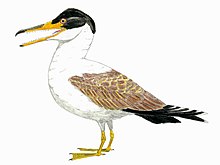Kuru kulla
Kuru (after Kurukullā, a Tibetan Buddhist deity) is a genus of dromaeosaurid theropod from the Late Cretaceous Barun Goyot Formation of Mongolia. The genus contains a single species, Kuru kulla, known from a fragmentary skeleton including a partial skull.[1]
| Kuru kulla Temporal range: Maastrichtian, | |
|---|---|
| Scientific classification | |
| Kingdom: | Animalia |
| Phylum: | Chordata |
| Clade: | Dinosauria |
| Clade: | Saurischia |
| Clade: | Theropoda |
| Family: | †Dromaeosauridae |
| Clade: | †Eudromaeosauria |
| Subfamily: | †Velociraptorinae |
| Genus: | †Kuru Napoli et al., 2021 |
| Species: | †K. kulla |
| Binomial name | |
| †Kuru kulla Napoli et al., 2021 | |
Discovery and naming
The holotype of Kuru kulla, IGM 100/981, was discovered by an American-Mongolian expedition at Khulsan in the Gobi Desert, Mongolia, on 5 July 1991, only hours before the discovery of Shri devi. The following year, it was reported as a distinct dromaeosaurid taxon at an SVP conference in Toronto. In their paper describing the dromaeosaurid Achillobator, Perle et al. (1999) listed a bibliographic entry titled "Morphology Dromaeosaurian dinosaur-Airakoraptor from the upper cretaceous of Mongolia".[2][3]
However, this bibliographic entry is clearly in error as no since paper existed and is definitely a reference to the SVP 1992 abstract, in which case "Airakoraptor" is a nomen nudum for IGM 100/981. Napoli et al. presumes the name "Airakoraptor" means "Kumis thief", after kumis, also known as airag or airak, a mare- or donkey-milk product made in Central Asia. In 1997 and 1999, the specimen was identified under the correct accession number in the scientific literature.[4][5]
In 2006, its surangular bone was described when Tsaagan was named.[6] Nevertheless, still in 2007 it was confused with the so-called Zos Wash specimen found in 1998, which in fact has the accession number IGM 100/3503.[7] The specimen IGM 100/981 was finally described in 2021 as the new genus and species Kuru kulla by James G. Napoli, Alexander Altieri Ruebenstahl, Bhart-Aanjan Singh Bhullar, Alan Hamilton Turner and Mark Allen Norell.[1]
Classification
Phylogenetic analysis places Kuru as the sister taxon of Adasaurus from the slightly later Nemegt Formation. A simplified version of said phylogenetic analysis is shown below:[1]
| Paraves |
| |||||||||||||||||||||||||||||||||||||||||||||||||||||||||||||||||||||||||||||||||||||||||||||||||||||||||||||||||||||||||||||||||
See also
References
- Napoli, J. G.; Ruebenstahl, A. A.; Bhullar, B.-A. S.; Turner, A. H.; Norell, M. A. (2021). "A New Dromaeosaurid (Dinosauria: Coelurosauria) from Khulsan, Central Mongolia" (PDF). American Museum Novitates. 2021 (3982): 1–47. doi:10.1206/3982.1. hdl:2246/7286. ISSN 0003-0082.
- Norell, Clark and Perle, 1992. New dromaeosaur material from the Late Cretaceous of Mongolia. Journal of Vertebrate Paleontology. 12(3), 45A.
- Perle, A.; Norell, M.A.; Clark, J.M. (1999). "A new maniraptoran Theropod – Achillobator giganticus (Dromaeosauridae) – from the Upper Cretaceous of Burkhant, Mongolia". Contribution No. 101 of the Mongolian-American Paleontological Project: 1–105.
- Norell, M.A., and P.J. Makovicky. 1997. "Important features of the dromaeosaur skeleton: information from a new specimen". American Museum Novitates 3215: 1–28
- Norell, M.A., and P.J. Makovicky. 1999. "Important features of the dromaeosaurid skeleton II: information from newly collected specimens of Velociraptor mongoliensis". American Museum Novitates 3282: 1–45
- Norell, M.A., Clark, James Matthew; Turner, Alan Hamilton; Makovicky, Peter J.; Barsbold, Rinchin & Rowe, Timothy. 2006. "A new dromaeosaurid theropod from Ukhaa Tolgod (Ömnögov, Mongolia). American Museum Novitates 3545: 1–51
- Turner, A.H., P.J. Makovicky, and M.A. Norell. 2007. "Feather quill knobs in the dinosaur Velociraptor. Science 317: 1721









.png.webp)


.jpg.webp)




